The AMD A8-7650K APU Review, Also New Testing Methodology
by Ian Cutress on May 12, 2015 10:00 AM ESTProfessional Performance: Windows
Agisoft Photoscan – 2D to 3D Image Manipulation: link
Agisoft Photoscan creates 3D models from 2D images, a process which is very computationally expensive. The algorithm is split into four distinct phases, and different phases of the model reconstruction require either fast memory, fast IPC, more cores, or even OpenCL compute devices to hand. Agisoft supplied us with a special version of the software to script the process, where we take 50 images of a stately home and convert it into a medium quality model. This benchmark typically takes around 15-20 minutes on a high end PC on the CPU alone, with GPUs reducing the time.
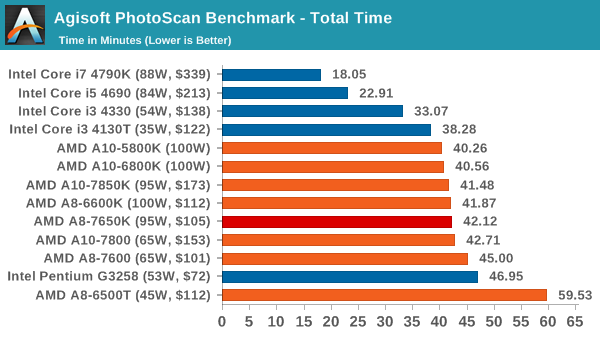
Photoscan prefers full threads and high IPC, so the low end i3, AMDs APUs and the G3258 all perform within a similar margin.
Cinebench R15
Cinebench is a benchmark based around Cinema 4D, and is fairly well known among enthusiasts for stressing the CPU for a provided workload. Results are given as a score, where higher is better.
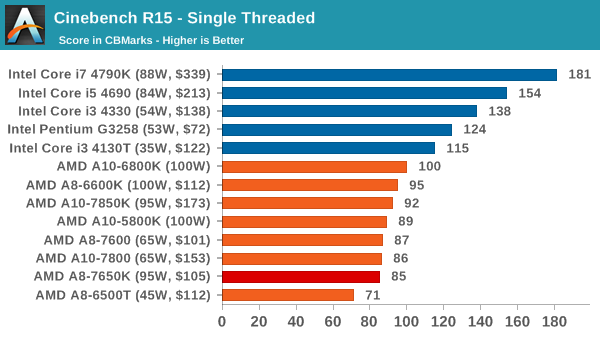
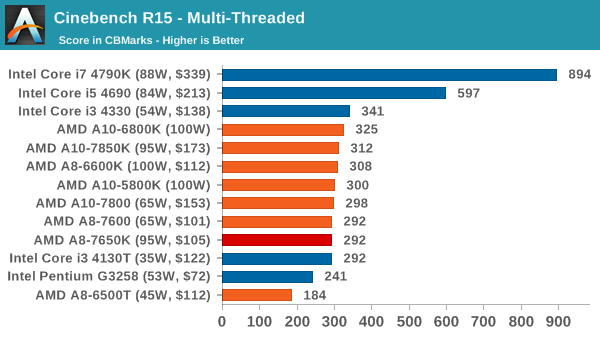
Despite the single thread performance, in multithreaded the gap between Pentium, i3-T, APU and i3 is similar to that seen in Photoscan.
HandBrake v0.9.9: link
For HandBrake, we take two videos (a 2h20 640x266 DVD rip and a 10min double UHD 3840x4320 animation short) and convert them to x264 format in an MP4 container. Results are given in terms of the frames per second processed, and HandBrake uses as many threads as possible.
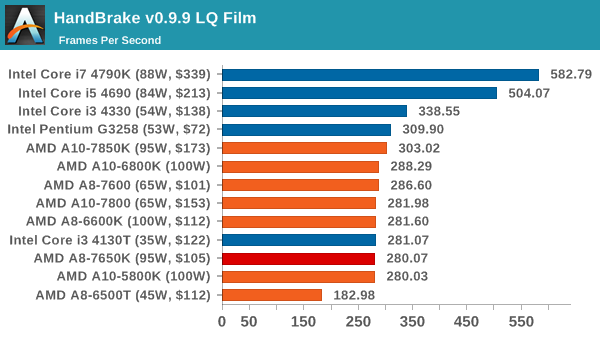
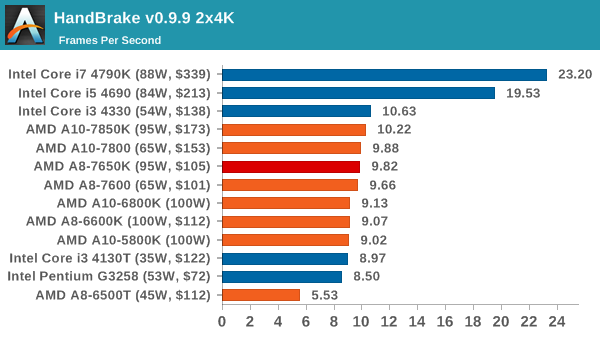
It's a similar story here, especially when we bring up 4K encoding in Handbrake. The APUs outperform the G3258 and the more expensive i3-T, but the i3-4330 is marginally quicker.
Hybrid x265
Hybrid is a new benchmark, where we take a 4K 1500 frame video and convert it into an x265 format without audio. Results are given in frames per second.
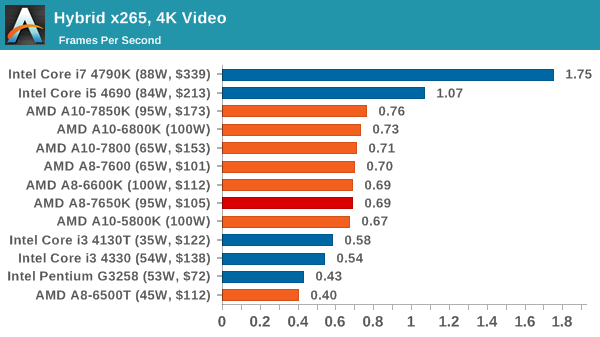










177 Comments
View All Comments
silverblue - Tuesday, May 12, 2015 - link
I heard a rumour that AMD were unable to meet demand and as such failed to secure a contract with Apple. Make of that what you will. As it was, Llano went from being under-produced to the exact opposite.galta - Tuesday, May 12, 2015 - link
Exactly: not only have they devised a poor strategy, they were also unable to follow it!V900 - Tuesday, May 12, 2015 - link
Nah, Llano would have been way too hot for an Apple laptop. Heck,'the CPU/GPU in a MacBook Air has a tdp of 15watt. Does AMD have anything even close to that, that doesn't involve Jaguar cores?galta - Tuesday, May 12, 2015 - link
Again, they were not able to deliver their strategy, even if it was a poor one.One says that integrated GPU is the future. That, per se, is questionable.
Later, we find out that they can't meet production orders and/or deliver a chip that is too hot for one of its potential markets. This is poor implementation.
Teknobug - Tuesday, May 12, 2015 - link
Enjoying my i3 4010U NUC as well, all I need for daily use and some occasional light gaming on Steam (I run Debian Linux on it).nerd1 - Tuesday, May 12, 2015 - link
Yoga 3 pro with 4.5W Core M got 90 points in Cinebench R15 Single-Threaded testThis 95W chip got 85 points in Cinebench R15 Single-Threaded test
So who's gonna buy this at all?
takeship - Tuesday, May 12, 2015 - link
Cynically, AMD may consider it better to have *any* product to discount/write-off down the road rather than fork over another wafer agreement penalty to GloFo with nothing to show for it.BrokenCrayons - Wednesday, May 13, 2015 - link
I noticed that as well, but the fact that this is a 95 watt processor isn't that much of a concern when you have the power envelope of a desktop chassis at your disposal. The intended niche for these APUs seems more to make a value proposition for budget gaming in a low-complexity system (meaning lacking the additional PCB complexity introduced by using a discrete GPU). Unfortunately, I don't see OEMs really putting any weight behind AMD APUs by selling systems containing them which leaves much of the sales up to the comparatively few people who DIY-build desktop hardware. Even those people are hard-pressed to find a lot of value in picking an APU-based platform over competing Intel products as they tend to have a little more budget flexibility and are targeting greater GPU performance than the A-series has available, putting them into discrete graphics solutions.zodiacfml - Wednesday, May 13, 2015 - link
The APU has more cores than that. In the test, did it tell you how much power it is using?yannigr2 - Tuesday, May 12, 2015 - link
Those two more and much more expensive Intel CPUs on the charts, make APUs look totally pathetic. Yes you do have the prices next to the charts, yes they do make APUs, look extremely valuable in the 3D games, but most people probably would not go past the first 4-5 pages in this article having being totally disappointed from the first results. Also the long blue lines will imprint in their memories, they will forget the prices.Next time throw a few Xeon e7 in the charts.
PS. PLEASE PLEASE PLEASE, don't turn to Tom's Hardware.